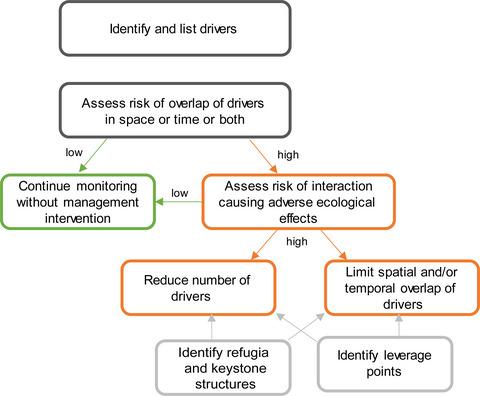当前位置:
X-MOL 学术
›
J. Appl. Ecol.
›
论文详情
Our official English website, www.x-mol.net, welcomes your
feedback! (Note: you will need to create a separate account there.)
Managing interacting disturbances: Lessons from a case study in Australian forests
Journal of Applied Ecology ( IF 5.0 ) Pub Date : 2020-06-28 , DOI: 10.1111/1365-2664.13696 David B. Lindenmayer 1, 2 , Claire N. Foster 1 , Martin J. Westgate 1 , Ben C. Scheele 1, 2 , Wade Blanchard 1
中文翻译:

管理相互作用的干扰:澳大利亚森林案例研究的经验教训
更新日期:2020-06-28
Journal of Applied Ecology ( IF 5.0 ) Pub Date : 2020-06-28 , DOI: 10.1111/1365-2664.13696 David B. Lindenmayer 1, 2 , Claire N. Foster 1 , Martin J. Westgate 1 , Ben C. Scheele 1, 2 , Wade Blanchard 1
Affiliation

|
- Ecosystems are shaped by a range of drivers including human and natural disturbances. They also may be subject to interactions between disturbances which can affect ecological processes, biodiversity and ecosystem condition; yet few ecosystems have been subject to multiple studies of the effects of interacting disturbances. This limits the understanding of ways to mitigate the impacts of interacting disturbances.
- Over the past 37 years, we have completed a range of studies of interacting effects in the Mountain Ash Eucalyptus regnans forests of south‐eastern Australia. Here we summarize evidence for interacting disturbances in this ecosystem. This includes evidence of linked or coupled disturbances (termed interaction chains; sensu Foster et al., Global Change Biology, 22, 2016, 1325) between logging and subsequent fire severity. We also describe effects of other interacting disturbances such as those resulting from post‐fire (salvage) logging as well as landscape‐level, spatio‐temporal changes in forest cover associated with logging and wildfires.
- Policy implications. Insights from research in Mountain Ash forests provide broader lessons for managing interacting disturbances in forest ecosystems. These include the importance of cataloguing and mapping multiple disturbances in both space and time and developing conceptual models of ecosystem dynamics and ecological processes. Where there is a high risk of interactions between disturbances, appropriate management actions could include: (a) eliminating some drivers or re‐assessing levels of human extraction of resources, (b) reducing the spatial and/or temporal overlap of drivers and (c) identifying leverage points where management actions are most likely to be effective.
中文翻译:

管理相互作用的干扰:澳大利亚森林案例研究的经验教训
- 生态系统由一系列驱动因素影响,包括人为和自然干扰。它们还可能受到各种干扰之间的相互作用的影响,这些相互作用可能影响生态过程,生物多样性和生态系统状况;然而,很少有生态系统受到相互作用干扰影响的多重研究。这限制了对减轻相互作用干扰影响的方法的理解。
- 在过去的37年中,我们已经完成了对澳大利亚东南部的山灰桉树regnans森林相互作用影响的一系列研究。在这里,我们总结了在该生态系统中相互作用的干扰的证据。这包括在伐木和随后的火灾严重性之间存在关联或耦合干扰(称为相互作用链; sensu Foster等人,Global Change Biology,22,2016,1325)的证据。我们还描述了其他相互作用的干扰的影响,例如火灾后(打捞)伐木以及与采伐和野火相关的森林覆盖的景观水平,时空变化。
- 政策含义。山灰森林研究的见识为管理森林生态系统中相互作用的干扰提供了更广泛的经验教训。其中包括在空间和时间上对多种干扰进行分类和制图的重要性,以及开发生态系统动力学和生态过程的概念模型的重要性。在干扰之间相互作用的风险很高的情况下,适当的管理措施应包括:(a)消除某些驱动因素或重新评估人类对资源的提取水平,(b)减少驱动因素的空间和/或时间重叠,以及(c )确定最有可能采取管理措施的杠杆点。











































 京公网安备 11010802027423号
京公网安备 11010802027423号